The Harlem Renaissance was the period from the 1910s through the mid-1930s when the New York City neighborhood of Harlem became the centerpiece of African-American culture, bursting with Black artists, poets, musicians, writers, dancers, and activists. “Renaissance Women,” by New York-based artist and educator Alice Mizrachi, is a sculpture of an abstracted feminine face. It looks like a line drawing inscribed in the air, as it is made of a single metal tube. Fittingly, the sculpture stands in Marcus Garvey Park in East Harlem, which is named for Harlem Renaissance activist Marcus Garvey. The sculpture honors the women of the Harlem Renaissance, like Zora Neale Hurston, Josephine Baker, Bessie Smith, Ethel Waters, Billie Holiday, Dorothy West, Augusta Savage, Lois Mailou Jones, and many more. Many of these women are still household names, and their lives and their work are still influential for scores of artists working today.
"Here" by Santi Flores

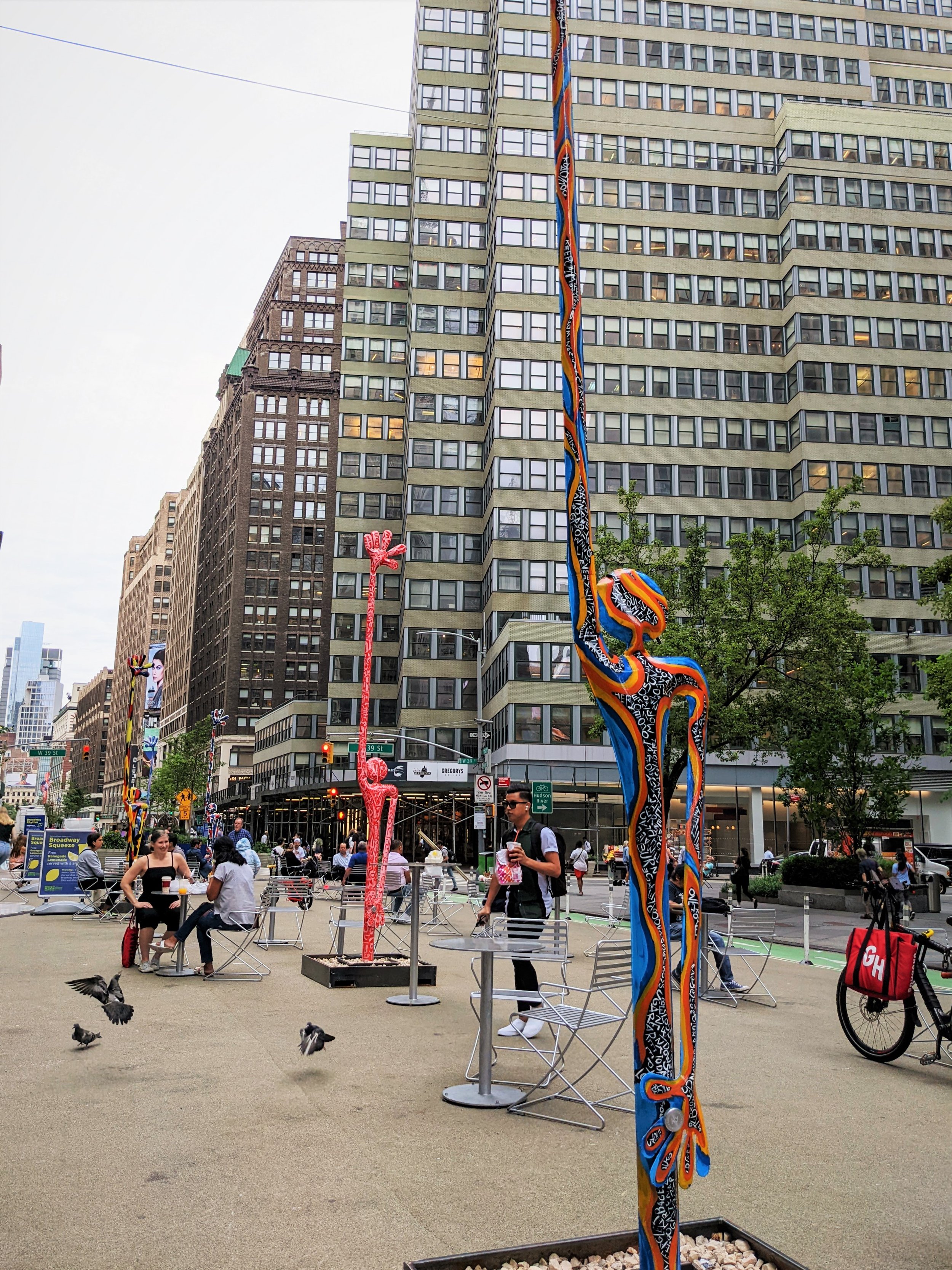
The city of New York, home to people from hundreds of different countries and cultures, takes great pride in its diversity. The Garment District, a neighborhood in midtown Manhattan, is currently home to an art installation celebrating the unique “unity, diversity, and individuality” of “New Yorkers and visitors passing through” the city. Called “Here,” the installation consists of fourteen figures standing in the pedestrian plaza with hands raised high in the air, “as if to say ‘Here we are. We are moving forward together.’” The installation is by Spanish artist Santi Flores, who created each figure out of steel and painted them with unique designs and patterns on their “skin.” The larger-than life figures are a whimsical tribute to New York and the people who live in and visit the city.
George Rickey on the Highline
One of the most influential American sculptors of the twentieth century, George Rickey spent much of his long career fascinated with the movements of the wind. He was captivated by “the waving of branches and the trembling of stems, the piling up or scudding of clouds, the rising and setting and waxing and waning of heavenly bodies.” His most famous sculptures reflect this preoccupation with movement. Rickey developed a distinct style of kinetic sculptures: simple, large-scale forms that were carefully balanced and calibrated to move with the slightest breeze. Several of these simple, gently moving pieces are currently on view at Kasmin Gallery’s rooftop sculpture garden in Chelsea, viewable from the High Line. The three works visible there, Five Lines in Parallel Planes, Peristyle II, and Two Red Lines, are all made up of elegant steel spikes, precisely balanced to sway and dip with the movements of the air. All created in the 1960s and 1970s, these pieces are emblematic of the sculptor’s signature style.
Brier Patch by Hugh Hayden
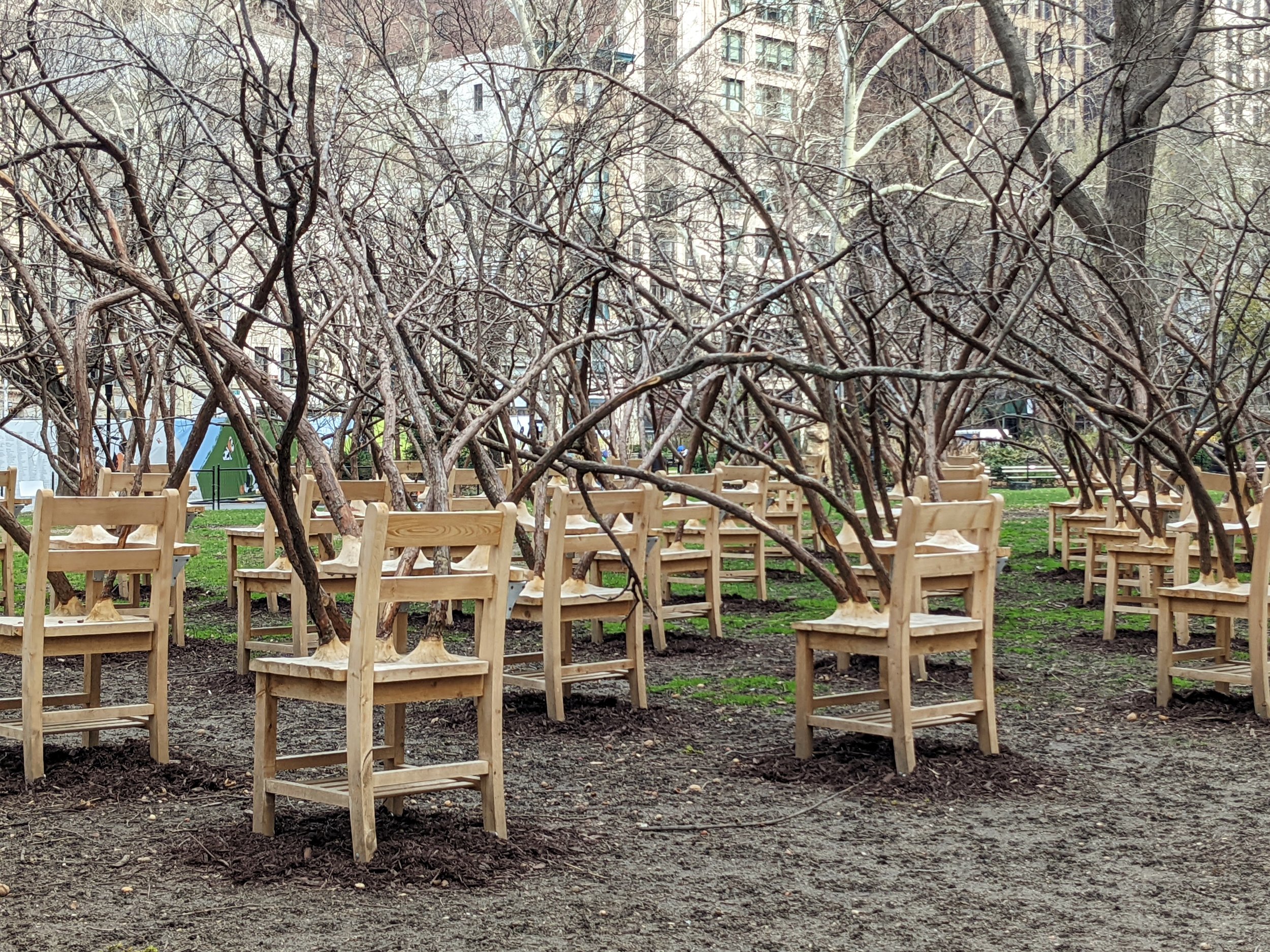
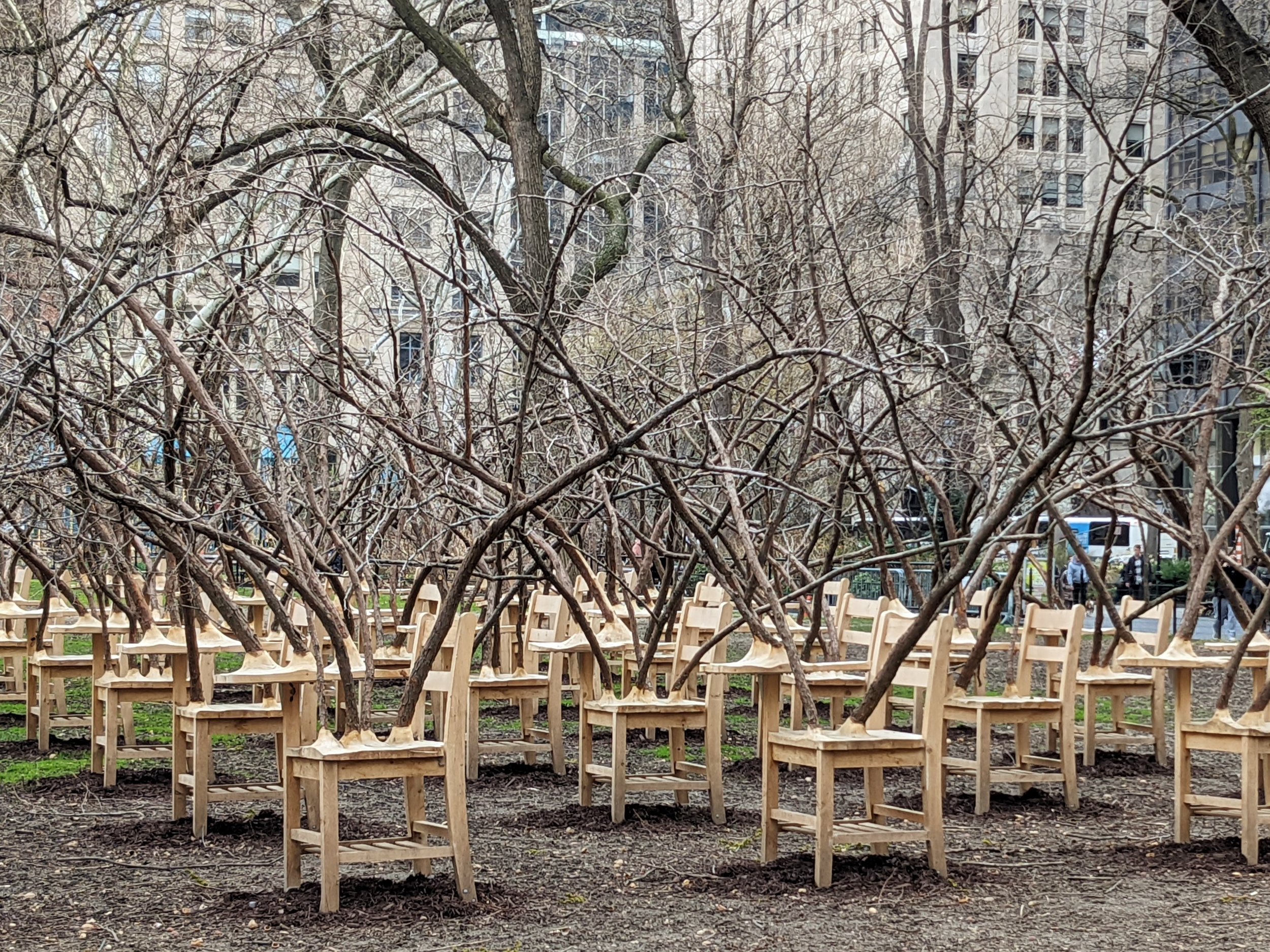

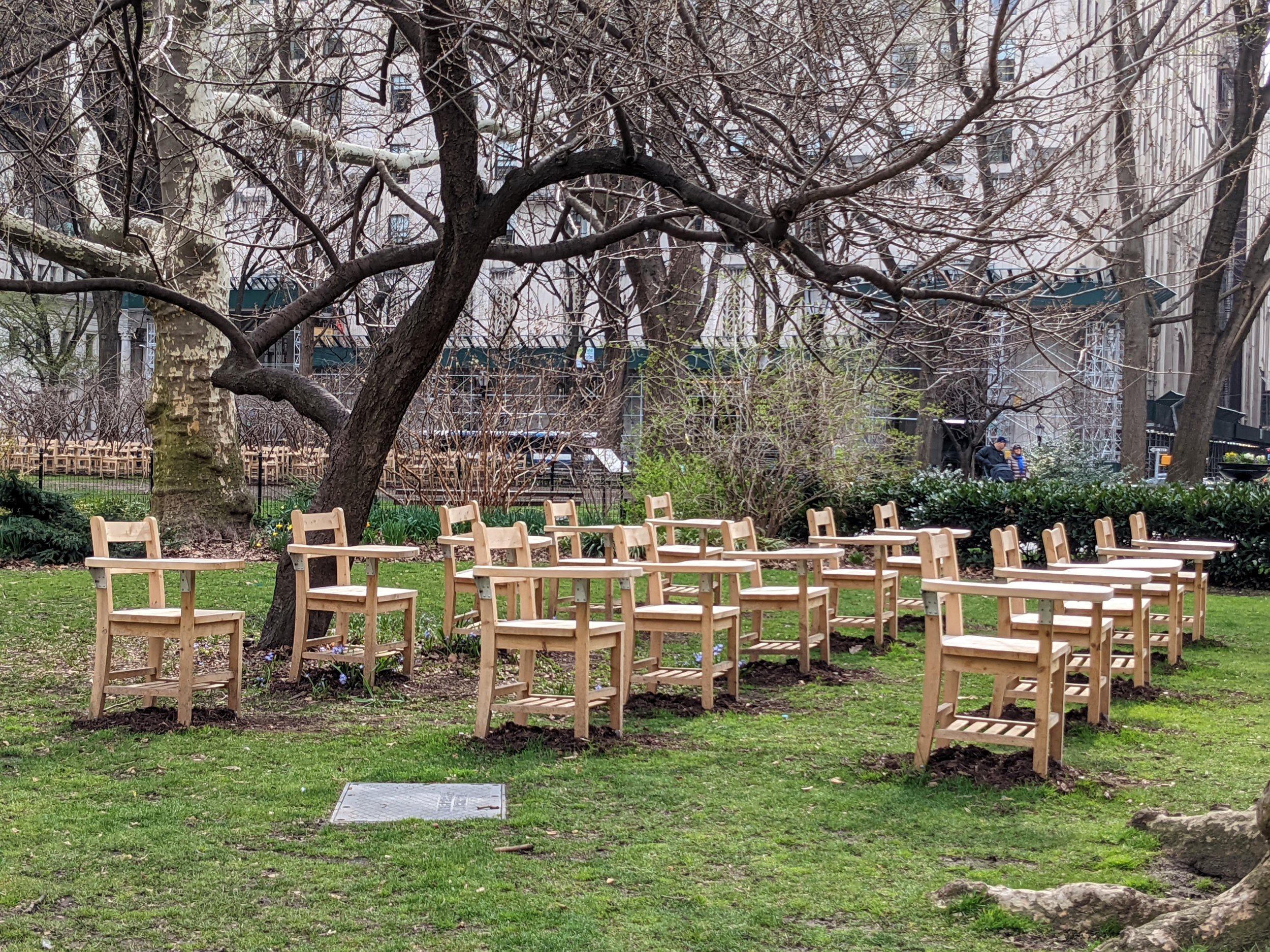
An unsettling assembly of school desks with branches growing from the surfaces is an unexpected sight in Madison Square Park. The installation by artist Hugh Hayden evokes in turn nostalgia, optimism, and foreboding. The desks, organized in neat rows like in a classroom, are disrupted by the twisting mass of branches that emerge from the seats of the chairs and the tops of the desks. Evocative of folklore stories like Br’er Rabbit and Sleeping Beauty, the canopy that forms could offer a safe place to hide, or prove to be dangerously prickly.
XO World Project
Shining in the sun, a massive, metal globe stands beside a silver jack, from the children’s game jacks, with crossed arms attached to the center spoke. The sculpture forms a giant “XO” in front of One World Trade Center. The sculpture by Daniel Anderson, called “XO World,” is part of the XO World Project, an initiative that aims to “encourage people of all ages to lend their voice and take action to advance the causes of peace, love and inclusion worldwide.” The artist says that he was inspired by “children and their open acceptance of others. A child’s mind and heart are free of prejudice regardless of race, gender, or religion,” an attitude that Anderson hopes will spread. Standing on the site of the tragedy of 9/11, the placement of the sculpture is evocative, adding an extra layer of pathos to the statue promoting peace and understanding. The shining sculpture sends a powerful message to anyone who sees it.
EL DORADO – The New Forty Niners by Cecile Chong
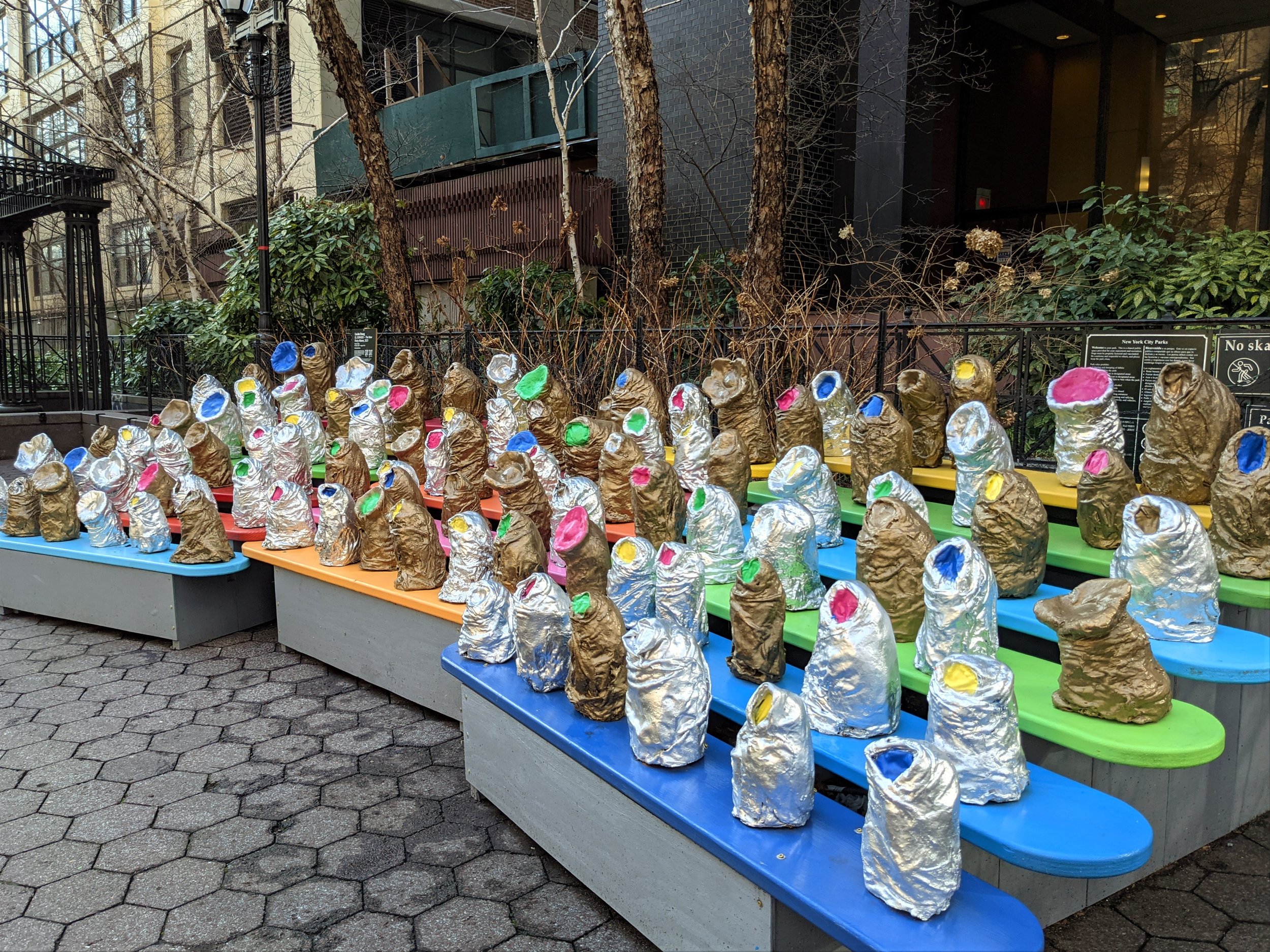
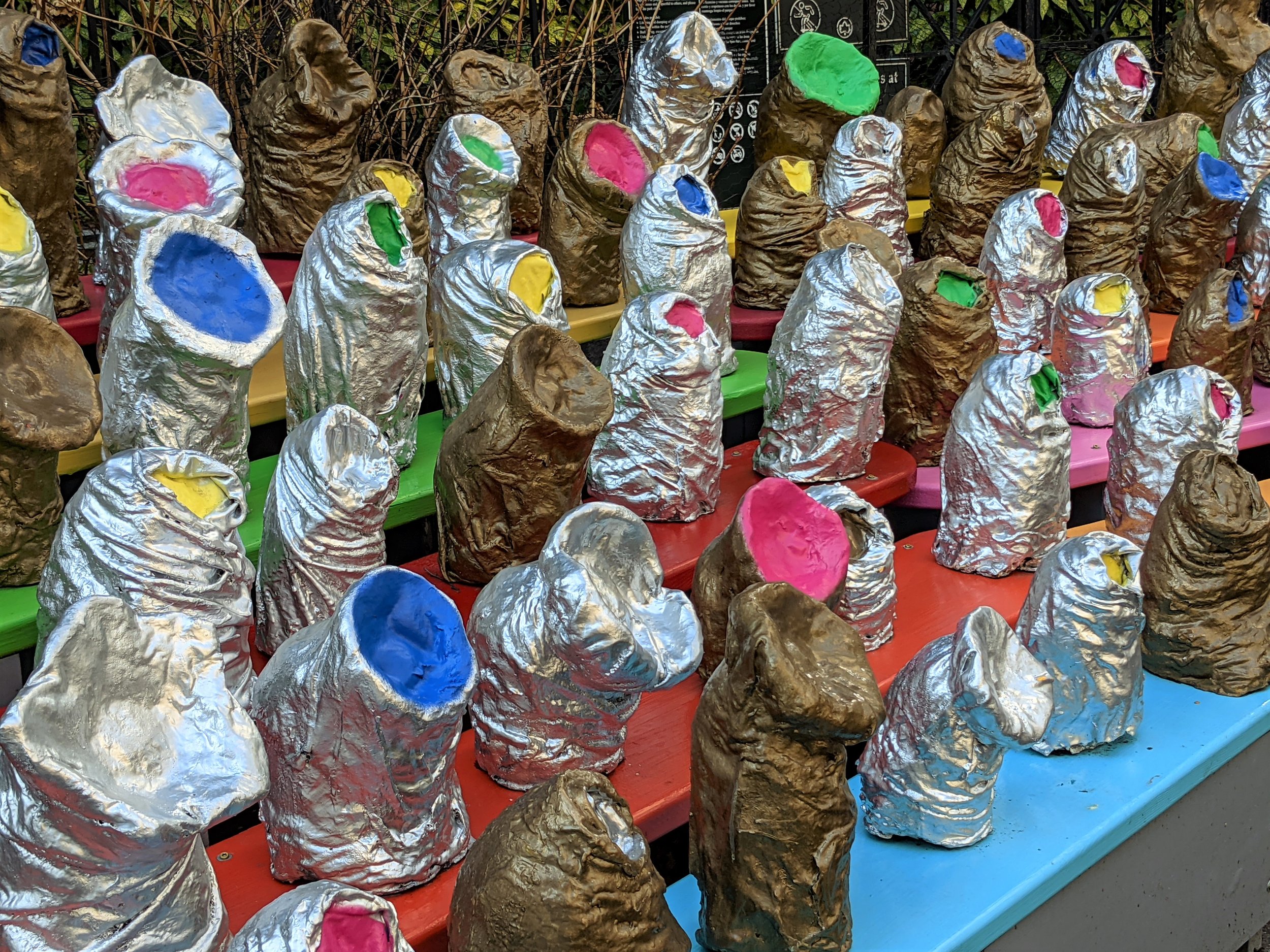
New York City is “the most linguistically diverse urban center in the world, probably in the history of the world.” The New York Metropolitan area is home to nearly twenty million people, who speak a total of over 800 languages. Forty-nine percent of households in New York City speak a language other than English. Artist Cecile Chong, originally from Ecuador and now living and working in New York, is interested in how and where world cultures overlap and interact. She created this installation, “EL DORADO – The New Forty Niners,” as a tribute to that forty-nine percent of households. The installation consists of one hundred “colored “guagua” (Quechua for baby) sculptures,” forty-nine of which are painted gold. It is a visual representation of the linguistic diversity of the city, and an endorsement of immigration and community.
Soul Ancestors by Magda Love
One of the largest murals in New York is painted on the wall of a public school in the West Village. The mural at City-As-School consists of three enormous compositions by well-known muralists Kobra, Cern, and Magda Love. “Soul Ancestors” is the name of the portion painted by artist Magda Love. Born in Argentina, the artist has lived in New York City for more than 15 years, and is dedicated to adorning the city with colorful, captivating work. With the goal of giving New Yorkers a moment of thoughtful pause in their hectic day, her work draws on her own experiences to portray themes of “vulnerability, strength, nostalgia, sorrow and joy.” The artist says that “Soul Ancestors” is a celebration of femininity, “a song to all women who are putting their souls in what they do.” The colorful artwork is a bright addition to the school building and the neighborhood.
Lunar New Year – Year of the Tiger
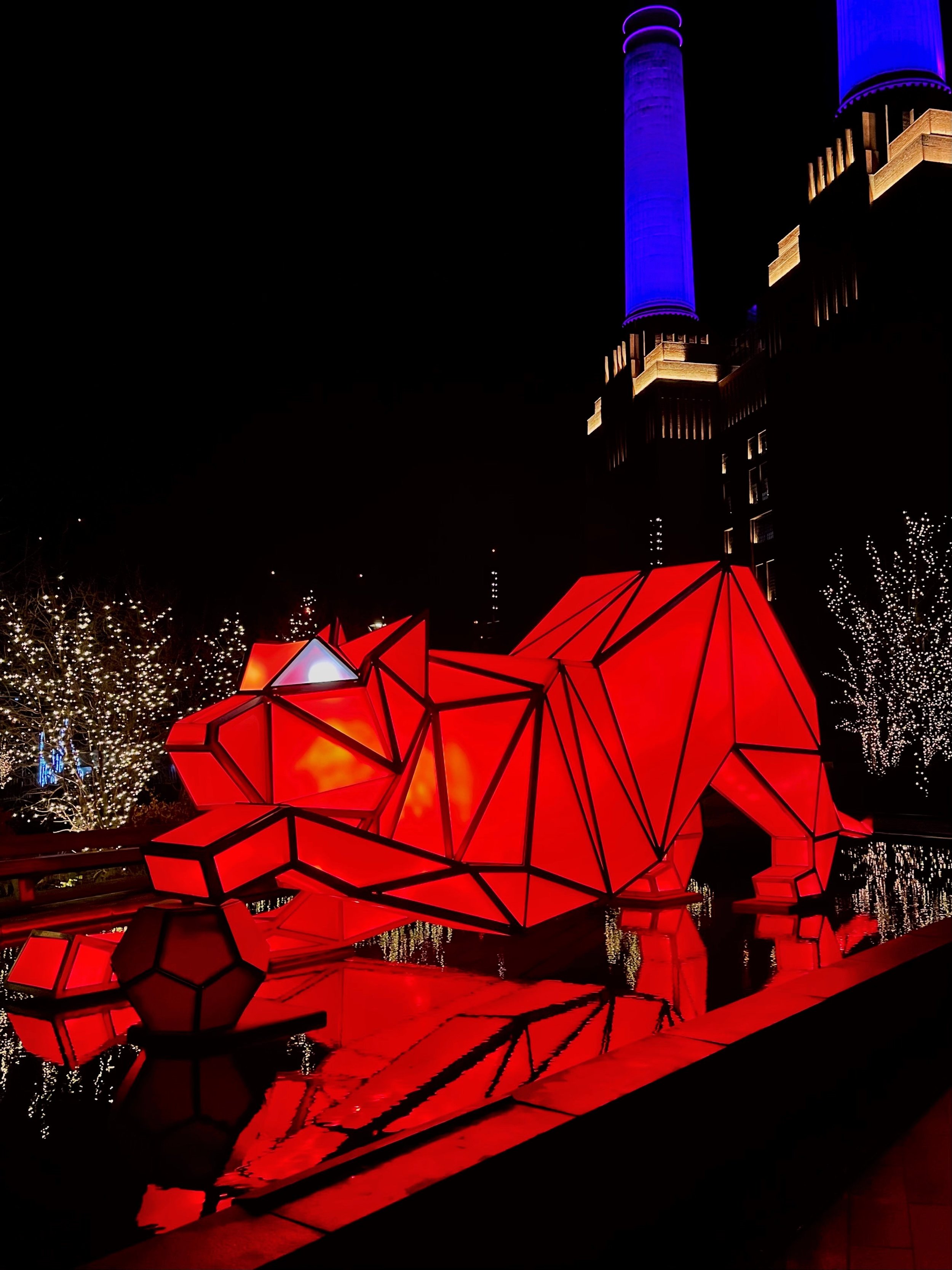
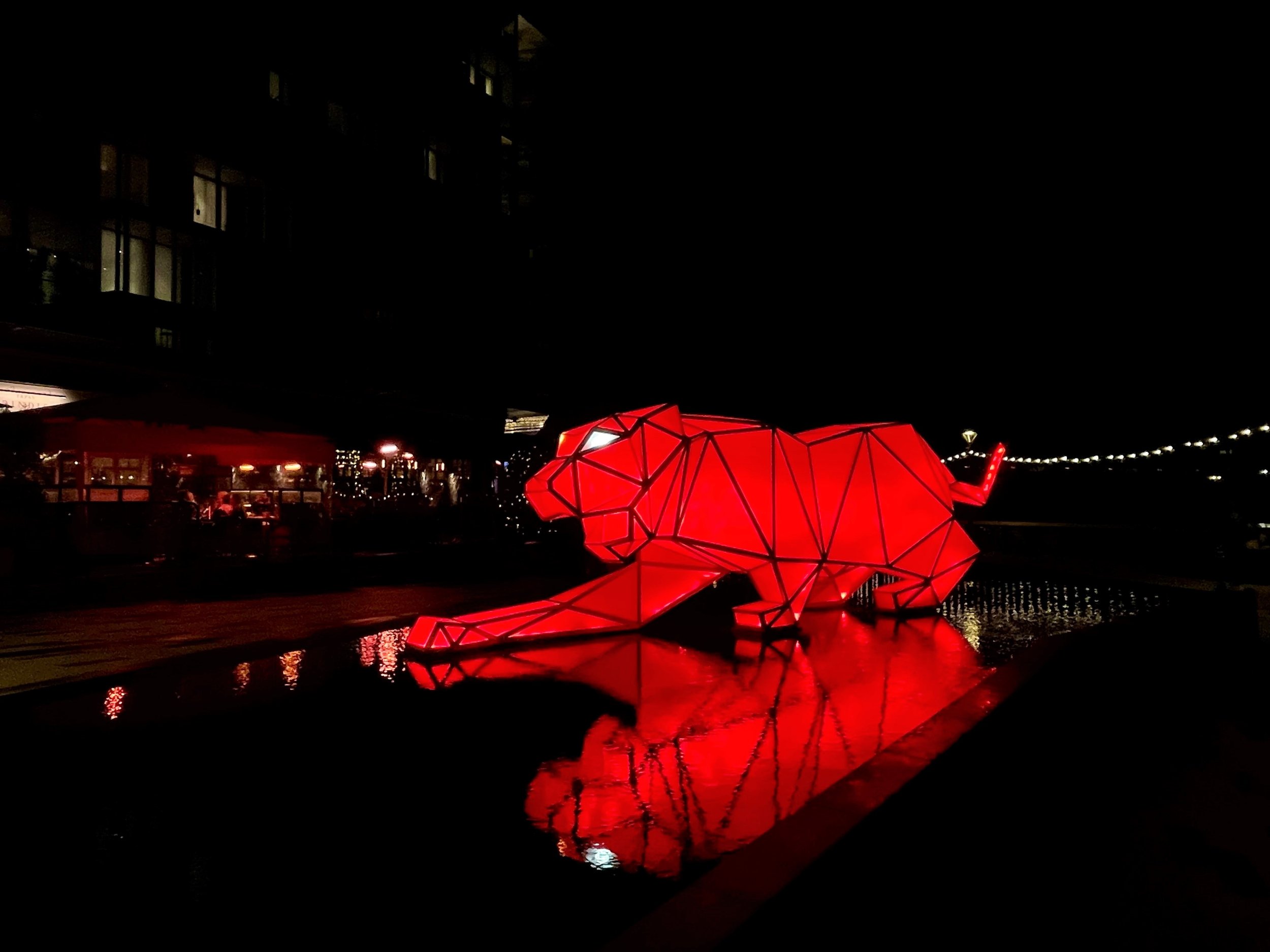

It’s time to celebrate a new year on the lunar calendar! Each year on the lunar calendar is associated with one of the 12 zodiac animals, which include the rat, ox, tiger, rabbit, dragon, snake, horse, sheep, monkey, rooster, dog, and pig. This upcoming year, which begins on February 1, is the year of the tiger. Lunar New Year is traditionally celebrated in China, Vietnam, North and South Korea, and Tibet, but today, celebrations take place all around the world. In London, for example, the Light Festival at Battersea Power Station features an installation celebrating the year of the tiger. The Laboratory for Visionary Architecture (LAVA) created “Digital Origami Tigers” in 2010, the last year of the tiger. The large, glowing sculptures “combine ancient methods of lantern making with cutting-edge design and technology” to create a stunning celebration of the new year.
Passage in the Garment District
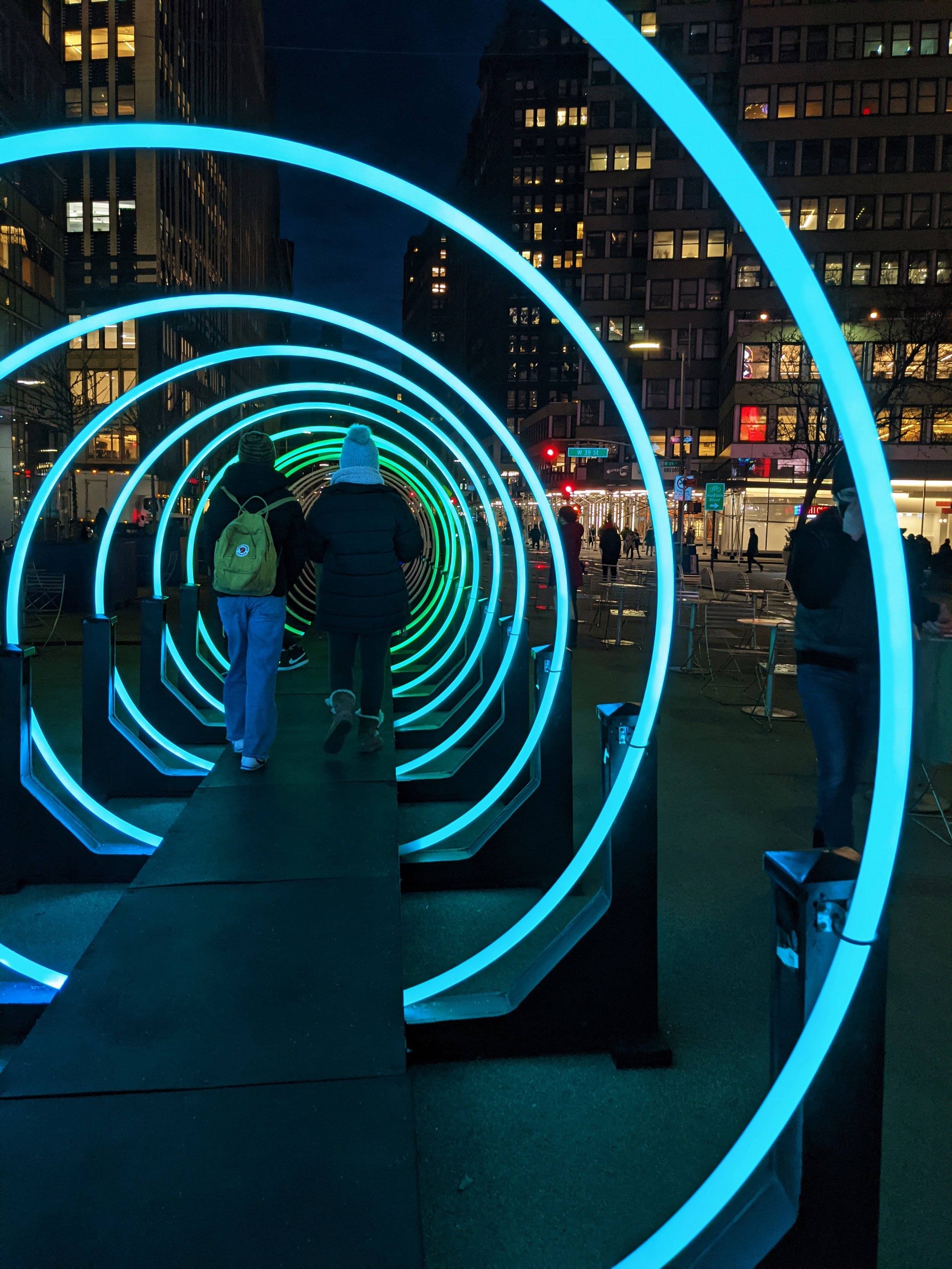
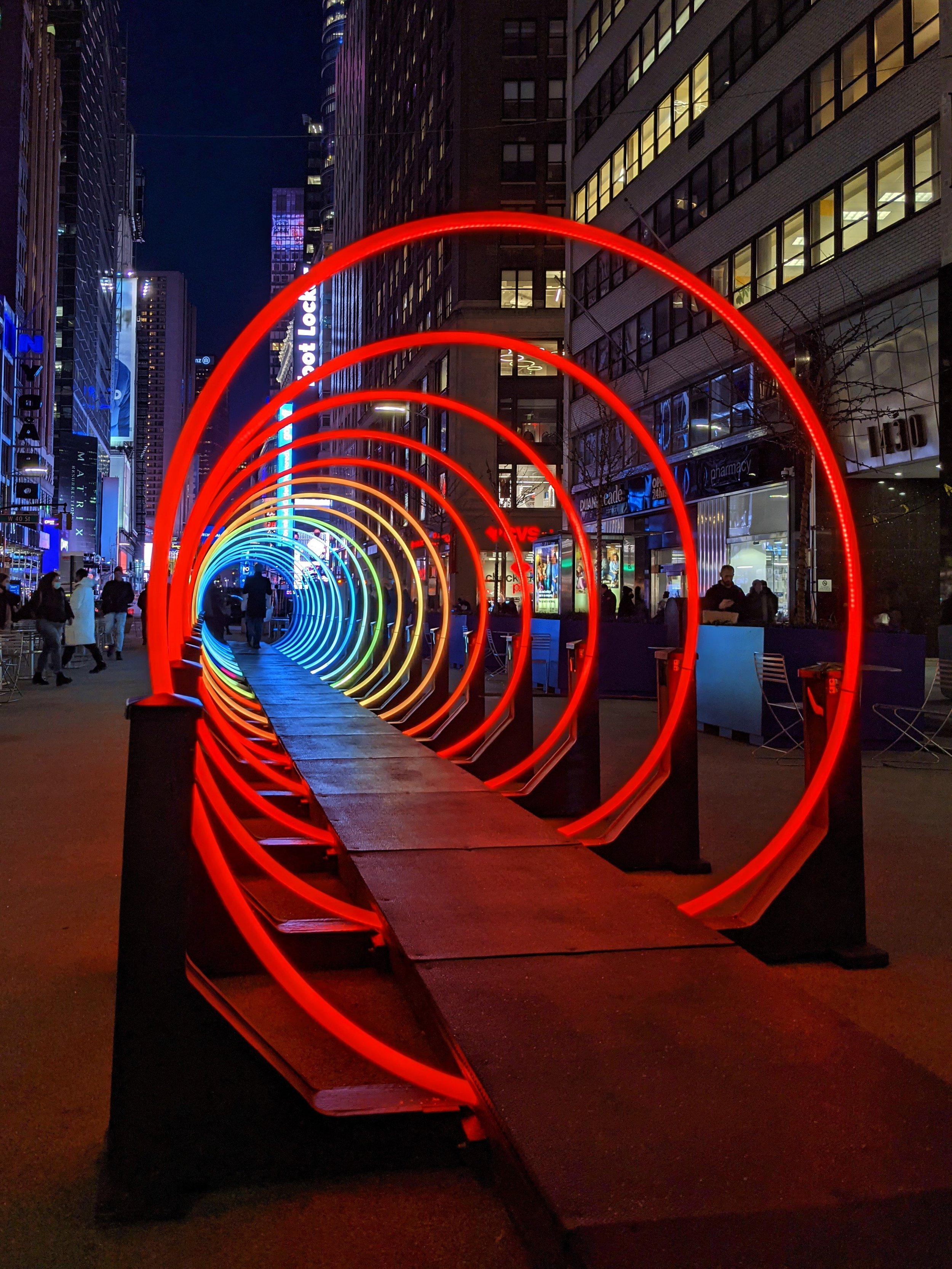
A new art installation is lighting up the Garment District! The interactive piece, called “Passage,” consists of twenty glowing rings that react with swirling color and sound as people pass through them. The artist, Serge Maheu, has a background in engineering, and is adept at creating artworks that use his technical skills in creative ways. This work was conceived as a meditation on the idea of transition and change, drawing on ideas of “passage in reference to the enigmatic moment between life and death.” Sponsored by the Québec Government Office in New York, the installation will only be in place for a few weeks, but in that time, it will bring color and fun to the chilly nights in midtown.
The Great Debate by Hebru Brantley
The Battery, at the southern tip of Manhattan, is home to a new larger-than-life sculpture. The piece, titled “The Great Debate,” is part of artist Hebru Brantley’s Flyboy series. The artist is known for creating narrative-driven art, often featuring his signature character, Flyboy. Described as “an exploration of what a superhero character of color would look like,” Flyboy can be found in comics, on murals, t-shirts, skateboards, and stickers, as well as in more traditional paint-on-canvas artworks. The 16-foot-tall statue in The Battery “features Flyboy in a stance that represents confident optimism.” The artist, Brantley, suggests, “My hope is that The Great Debate at The Battery will serve as a consistent reminder to hold your head high, stand firm in what you believe in, and keep pushing forward with confidence.”




